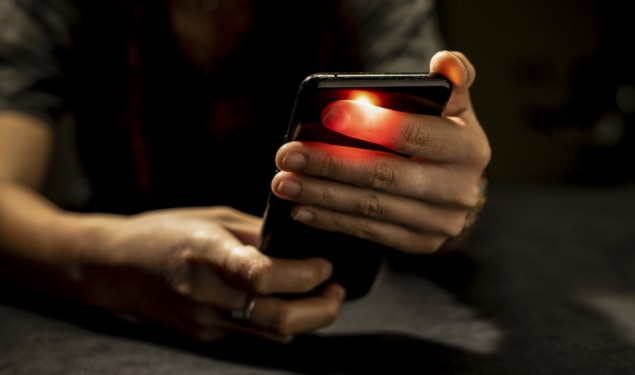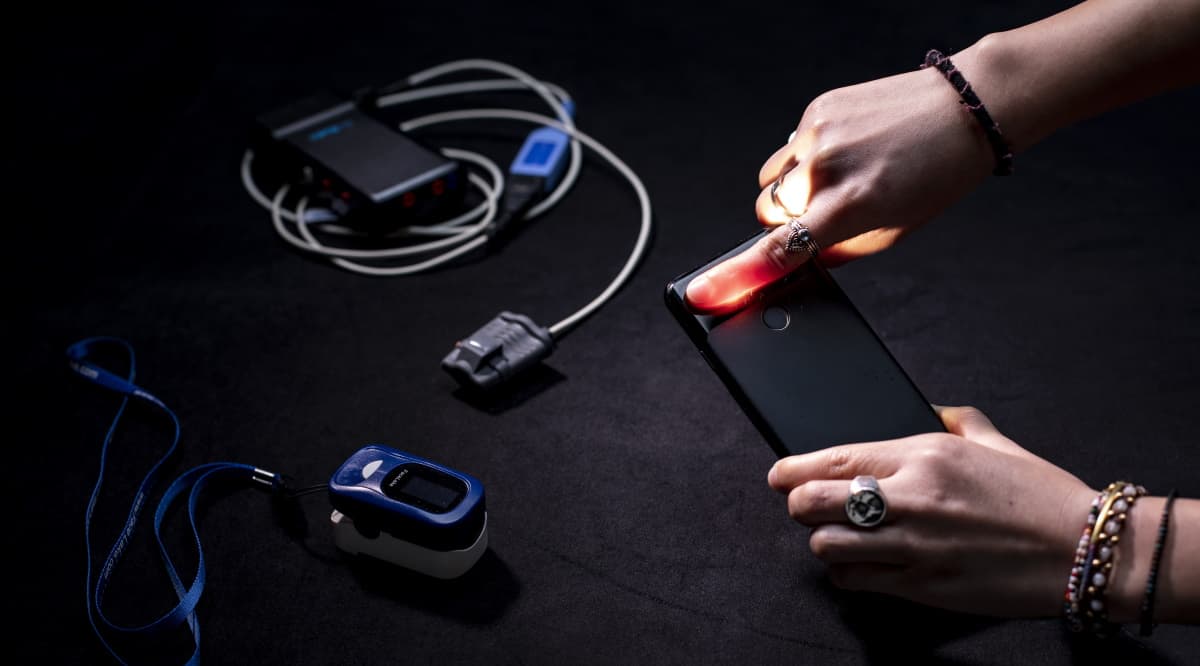
Blood-oxygen saturation (SpO2), the percentage of haemoglobin in the blood carrying oxygen, is an important measure of cardiovascular function. Healthy individuals have SpO2 levels of roughly 95% or above, but respiratory illnesses – such as asthma, chronic obstructive pulmonary disease, pneumonia and COVID-19 – can cause these levels to drop significantly. And if SpO2 falls below 90%, this can be a sign of more serious cardiopulmonary disease.
Doctors usually measure SpO2 using pulse oximeters, non-invasive devices that clip onto the fingertip or ear. These typically work via transmittance photoplethysmography (PPG), in which the absorption of red and IR light is analysed to distinguish oxygenated from deoxygenated blood. But the ability to monitor SpO2 outside of the clinic, using the camera on an everyday smartphone, could allow more people to detect situations that need medical follow-up or keep track of ongoing respiratory conditions.
Researchers at the University of Washington (UW) and University of California San Diego have now shown that smartphones can detect blood-oxygen saturation levels down to 70%. Reporting their findings in npj Digital Medicine, they note that this was achieved using smartphone cameras with no hardware modifications, by training a convolutional neural network (CNN) to decipher a wide range of blood-oxygen levels.
In a proof-of-principle study, the researchers employed a procedure called varied fractional inspired oxygen (FiO2), in which the subject breathes a controlled mixture of oxygen and nitrogen, to slowly reduce their SpO2 levels to below 70% – the lowest value that pulse oximeters should be able to measure, as recommended by the US Food and Drug Administration. They used the resulting data to train the CNN-based deep-learning algorithm.
“Other smartphone apps were developed by asking people to hold their breath. But people get very uncomfortable and have to breathe after a minute or so, and that’s before their blood-oxygen levels have gone down far enough to represent the full range of clinically relevant data,” explains first author Jason Hoffman, a UW doctoral student, in a press statement. “With our test, we’re able to gather 15 minutes of data from each subject. Our data show that smartphones could work well right in the critical threshold range.”
Hoffman and colleagues examined six healthy volunteers. Each participant underwent varied FiO2 for 13–19 min, during which time the researchers acquired more than 10,000 blood-oxygen level readings between 61% and 100%. Alongside, they used purpose-built pulse oximeters to record ground-truth data via transmittance PPG.

To perform smartphone oximetry, the participant places their finger over the camera and flash of a smartphone. The camera records responses via reflectance PPG – measuring how much light from the flash the blood absorbs in each of the red, green and blue channels. The researchers then fed these intensity measurements into the deep-learning model, using four subjects’ data as the training set and one for validation and optimizing the model. They then evaluating the trained model on the remaining subject’s data.
When trained across a clinically relevant range of SpO2 levels (70–100%) from the varied FiO2 study, the CNN achieved an average mean absolute error of 5.00% in predicting a new subject’s SpO2 level. The average R2 correlation between the model predictions and the reference pulse oximeter was 0.61. The average RMS error was 5.55% across all subjects, higher than the 3.5% standard required for reflectance pulse oximeter devices to be cleared for clinical use.
The researchers suggest that rather than simply estimating SpO2, the smartphone camera oximeter could be used as a tool to screen for low blood oxygenation. To explore this approach, they calculated their model’s classification accuracy for indicating whether an individual has an SpO2 level below three thresholds: 92%, 90% (commonly used to indicate the need for further medical attention) and 88%.
When classifying SpO2 levels below 90%, the model exhibited a relatively high sensitivity of 81% and a specificity of 79%, averaged across all six test subjects. For classifying SpO2 below 92%, the specificity increased to 86%, with a sensitivity of 78%.
The researchers point out that, statistically, the study does not indicate that this approach is ready to be used as a medical device comparable with current pulse oximeters. They note, however, that the performance level seen from this small test subject sample indicates that the model accuracy could be increased by acquiring more training samples.

Smartphone camera measures blood glucose concentration
For example, one of the subjects had thick calluses on their fingers, which made it harder for the algorithm to accurately determine their blood-oxygen levels. “If we were to expand this study to more subjects, we would likely see more people with calluses and more people with different skin tones,” Hoffman explains. “Then we could potentially have an algorithm with enough complexity to be able to better model all these differences.”
Hoffman tells Physics World that the team does not have any plans to immediately commercialize this technology. “However, we have developed a testing plan and grant proposals that would enable us to test on a larger, more diverse group of subjects to see whether this proof-of-principle study is reproducible and potentially ready for commercially focused development,” he says.
